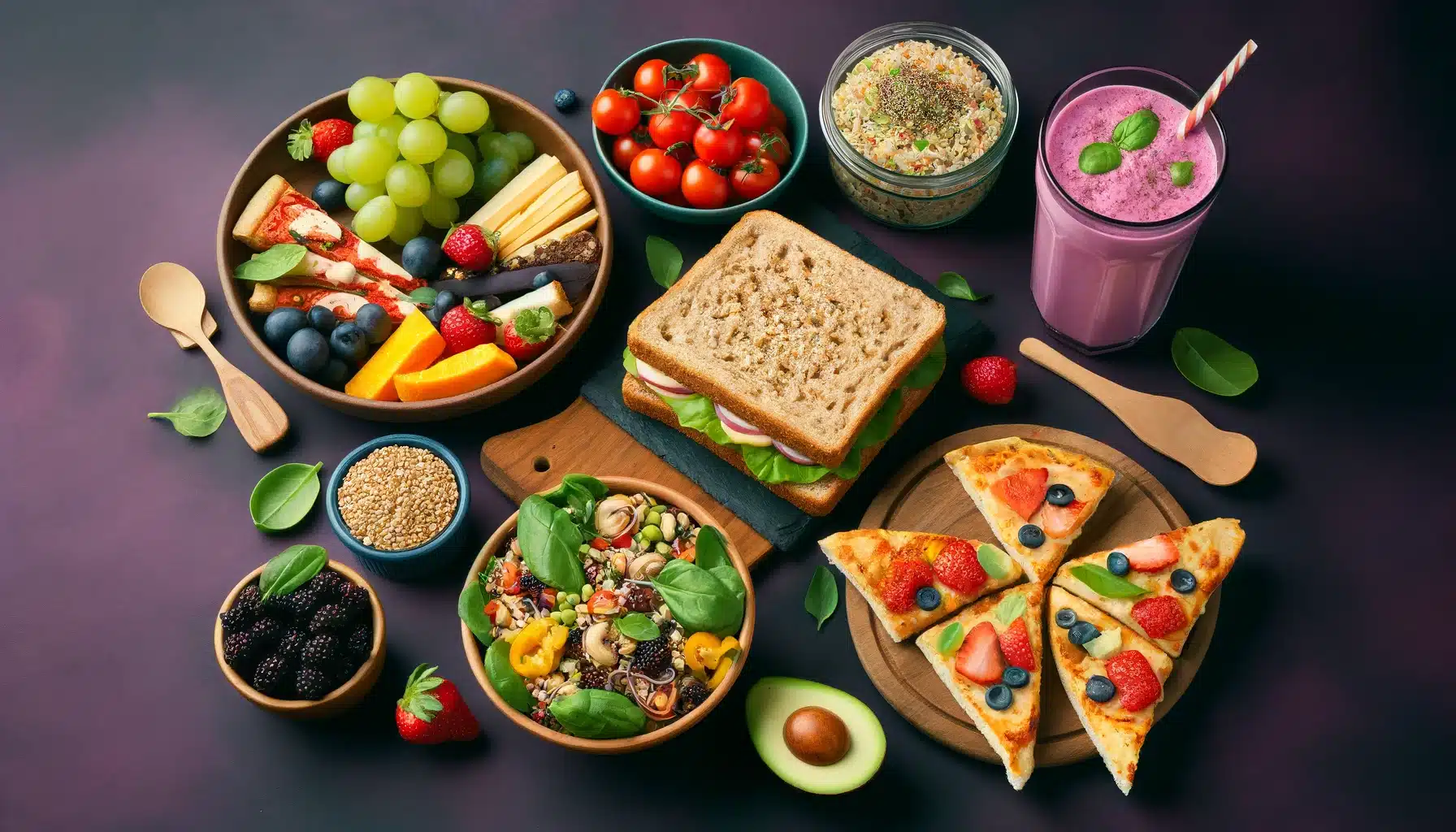Navigating your child’s lunch menu can be like steering a ship through uncharted waters. But don’t fret; you’re not alone. We’re here to guide you on this culinary adventure. From understanding their nutritional needs to exploring diverse lunch options, we’ll dive into the world of healthy, fun, and tasty meals. Together, we’ll conquer picky eater battles and introduce new foods in a way that’ll have your little ones asking for seconds. Let’s set sail!
Understanding Kids Nutritional Needs: Key Takeaways
- Balancing nutrients is crucial for kids’ growth and overall health.
- Introduce your child to new flavours, ingredients, and cooking styles.
- Use colourful vegetables and fruits to create a vibrant plate.
- Introduce new foods gradually to diversify your child’s taste palette.
- Introduction to Healthy Eating
- Healthy eating is essential for children’s growth and development. A balanced diet provides the necessary nutrients for kids to thrive physically and mentally. As a parent, it’s crucial to understand your child’s nutritional needs and make healthy foods fun and accessible. In this section, we’ll explore the basics of healthy eating for kids and provide tips on encouraging a lifelong love of nutritious food.
In this Article
Understanding Kids’ Nutritional Needs
Before you start introducing new foods to your child’s lunchbox, it’s crucial to understand the nutritional needs and the importance of a balanced child’s diet during their growing years. Balancing nutrients is a delicate juggling act. You’re aiming for a mix of proteins for growth, carbohydrates for energy, and vitamins and minerals for overall health. It’s not an exact science, but a colourful, varied diet is usually a good start.
Now, let’s tackle understanding allergies. It’s part of your role to be aware of any potential allergies your child might have. Common culprits include dairy, nuts, and gluten. Contact a healthcare professional immediately if there are any signs of allergic reactions, such as hives, itching, or difficulty breathing. Remember, it’s always better to be safe than sorry.
Feeding your child can feel daunting, but you’re not alone in this journey. You’re part of a community of parents navigating these same challenges. We’re all learning, experimenting, and growing together. So, please take a deep breath and remember that your child’s nutritional needs are important, and understanding them is the first step towards a healthier lunchbox and a healthier child.

Transitioning to Solid Foods
Transitioning to solid foods is an exciting milestone in a baby’s life. Around 4-6 months old, babies are ready to start exploring solid foods. The American Academy of Pediatrics recommends introducing single-ingredient foods, such as pureed fruits and vegetables, and gradually increasing the variety of foods. Introducing new foods gradually is essential, allowing your baby to become accustomed to new tastes and textures. Start with small bites, and don’t be afraid to get creative with finger foods and solid foods. Always supervise your baby during mealtime and never leave them alone with food.
Here are some tips for transitioning to solid foods:
- Start with single-ingredient foods, such as pureed fruits and vegetables.
- Introducing new foods gradually makes your baby accustomed to new tastes and textures.
- Start with small bites, and don’t be afraid to get creative with finger foods and solid foods.
- Always supervise your baby during mealtime and never leave them alone with food.
- Make mealtime fun and engaging, using creative plating and presentation to encourage exploration.
Following these tips and gradually introducing healthy foods will set your child up for a lifelong love of nutritious eating. Always consult your pediatrician if you have any concerns or questions about your child’s diet.
Exploring Diverse Lunch Options
Now, to pack a healthier lunchbox, it’s time to step outside the box and explore a wide array of diverse food options for your little one. Around 4-6 months old, babies are ready to explore solid foods, often beginning with baby food. This journey, which we’ll call ‘Cultural Cuisine Exploration,’ could involve tasting food from around the world and introducing your child to a wealth of new flavours, ingredients, and cooking styles. During this transition, breast milk should continue to be a significant part of a baby’s diet. This exploration isn’t just about new tastes but also about creating an understanding and appreciation of different cultures. Mixing initial foods with breast milk or infant formula can help ease the transition.
Try incorporating foods like sushi rolls, mini falafels, or a colourful Greek salad. Providing the same food daily for a few days helps monitor for any adverse reactions. These food items provide a balance of protein, carbs, and vitamins that your child needs. Plus, they’re fun to eat!
Next, let’s focus on ‘Lunchbox Presentation Tips’. We know how important first impressions are; the same applies to food. So, make the lunchbox visually appealing. Use colourful food items, cut fruits or sandwiches into interesting shapes, or arrange them creatively. This doesn’t just make the lunchbox attractive but also makes discovering new foods exciting for your young one. Remember, your goal is to make lunchtime an adventure, not a chore.
Making Healthy Foods Fun
This exciting culinary adventure is about introducing healthy foods to your child’s lunchbox and making it a fun experience. Transforming lunchtime into a delightful game can help foster their curiosity and willingness to try new foods. Here’s how:
- Creative Plating: Use colourful vegetables and fruits to create a vibrant canvas on your child’s plate. You can shape them into a smiley face, a cute animal, or their favourite cartoon character. This playful presentation will surely tempt them.
- Recipe Experimentation: Don’t shy away from mixing different ingredients to create unique flavours. Add a splash of creativity and let your child participate in the cooking process. This can be an excellent way to bond, learn, and discover new tastes.
- Fun Dips: Kids love to dip their food. So, why not make some healthy dips like hummus or yogurt-based sauces? It’s a fantastic way to add extra nutrients and make their lunch more interactive.
Gradual Introduction of New Foods
As you venture further on this culinary journey with your child, gradually introducing new foods to their diet can be a strategic and practical approach. This process diversifies their taste palette and aids in their taste development. But remember, it’s not a race. You’re nurturing a lifelong relationship with food, so it’s important to take it slow.
While introducing new foods, it’s important to limit processed foods, which often contain higher amounts of salt and preservatives.
Consider introducing one new food at a time, giving your child plenty of time to acquaint themselves with its texture, aroma, and flavour. This way, you’ll better understand their likes and dislikes, and if any food allergies arise, you’ll be better equipped to pinpoint the culprit.
Remember that it takes time for young ones to accept new foods. They may need to be exposed to a new flavour multiple times before they develop a liking for it. Don’t get disheartened if they initially reject a new food. Remember, you’re not alone in this journey. You’re part of a community of parents navigating the same path.
As you continue to explore new culinary horizons with your child, you may find that they become picky about their food choices. But don’t worry—our next topic is dealing with picky eaters.
Dealing With Picky Eaters
Navigating your child’s picky eating habits might seem daunting, but don’t lose heart—you’ve got this! Dealing with a young one who is selective about food can be challenging, but with the right mealtime strategies, you can turn this into an opportunity for palate expansion.
- Incorporate their favourites: This is a simple, practical starting point. If they love apples, for instance, try introducing similar fruits. This way, they’ll be more open to trying new things.
- Make meals fun: Use their favourite characters or themes to make the meal visually appealing.
- Encourage participation: Get them involved in meal preparation. They’re more likely to eat something they’ve helped create.
Conclusion
Embracing the adventure of new foods with your little one can be as fun as a picnic on a sunny day. Remember, their nutritional needs are the compass guiding this journey. With a dash of creativity, a sprinkle of patience, and a buffet of diverse options, you’re well on your way to keeping meal times exciting and healthy. Here’s to turning picky eaters into curious food explorers, one tasty lunch at a time!









